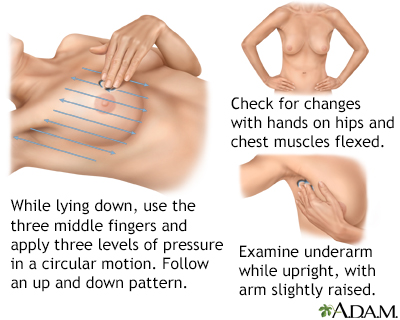Pregnancy SmartSiteTM
Mammogram - breast cancer screening; Breast exam - breast cancer screening; MRI - breast cancer screening DefinitionBreast cancer screenings can help find breast cancer early, before you notice any symptoms. In many cases, finding breast cancer early makes it easier to treat or cure. But screenings also have risks, such as missing signs of cancer. When to start screenings may depend on your age and risk factors. MammogramsA mammogram is the most common type of screening. It is an x-ray of the breasts using a special machine. This test is done in a hospital or clinic and only takes a few minutes. Mammograms can find tumors that are too small to feel. Mammography is performed to screen women to detect early breast cancer when it is more likely to be cured. The recommendations of different expert organizations can differ.
Mammograms work best at finding breast cancer in women ages 40 to 74. It is not clear how well mammograms work at finding cancer in women age 75 and older. Breast ExamsThis is an exam to feel the breasts and underarms for lumps or unusual changes. Your provider may perform a clinical breast exam (CBE). You can also check your breasts on your own. This is called a breast self-exam (BSE). Doing self-exams may help you become more familiar with your breasts. This may make it easier to notice unusual breast changes. Keep in mind that breast exams do not reduce the risk of dying from breast cancer. They also do not work as well as mammograms to find cancer. For this reason, you should not rely only on breast exams to screen for cancer. Not all experts agree about when to have or start having breast exams. In fact, some groups do not recommend them at all. However, this does not mean you should not do or have breast exams. Some women prefer to have exams. Talk with your provider about the benefits and risks for breast exams and if they are right for you. MRI (Magnetic Resonance Imaging)An MRI uses powerful magnets and radio waves to find signs of cancer. This screening is done only for women who have a high risk for breast cancer. Women at high risk for breast cancer (greater than 20% to 25% lifetime risk) should have an MRI along with a mammogram every year. You may have a high risk if you have:
It is not clear how well MRIs work to find breast cancer. Although MRIs find more breast cancers than mammograms, they are also more likely to show signs of cancer when there is no cancer. This is called a false-positive result. For women who have had cancer in one breast, MRIs can be very helpful for finding hidden tumors in the other breast. You should do a MRI screening if you:
Benefits and Risks of ScreeningsWhen and how often to have a breast cancer screening test is a choice you must make. Different expert groups do not fully agree on the best timing for screening. Before having a mammogram, talk to your provider about the pros and cons. Ask about:
Risks of screenings can include:
ReferencesHenry NL, Shah PD, Haider I, Freer PE, Jagsi R, Sabel MS. Cancer of the breast. In: Niederhuber JE, Armitage JO, Kastan MB, Doroshow JH, Tepper JE, eds. Abeloff's Clinical Oncology. 6th ed. Philadelphia, PA: Elsevier; 2020:chap 88. National Cancer Institute website. Breast cancer screening (PDQ) - health professional version. www.cancer.gov/types/breast/hp/breast-screening-pdq. Updated March 28, 2024. Accessed September 16, 2024. US Preventive Services Task Force, Nicholson WK, Silverstein M, et al. Screening for breast cancer: US Preventive Services Task Force recommendation statement. JAMA. 2024;331(22):1918-1930. PMID: 38687503 pubmed.ncbi.nlm.nih.gov/38687503/. | ||
| ||
Review Date: 9/6/2024 Reviewed By: Warren Brenner, MD, Oncologist, Lynn Cancer Institute, Boca Raton, FL. Review provided by VeriMed Healthcare Network. Also reviewed by David C. Dugdale, MD, Medical Director, Brenda Conaway, Editorial Director, and the A.D.A.M. Editorial team. View References The information provided herein should not be used during any medical emergency or for the diagnosis or treatment of any medical condition. A licensed medical professional should be consulted for diagnosis and treatment of any and all medical conditions. Links to other sites are provided for information only -- they do not constitute endorsements of those other sites. No warranty of any kind, either expressed or implied, is made as to the accuracy, reliability, timeliness, or correctness of any translations made by a third-party service of the information provided herein into any other language. © 1997- A.D.A.M., a business unit of Ebix, Inc. Any duplication or distribution of the information contained herein is strictly prohibited. | ||


 Mammary gland
Mammary gland Mammogram
Mammogram Breast self-exam
Breast self-exam
